rrbigdog
New member
More sharing.
Here is my box for my frag tank.... not all your bells and whistles but will be perfect. Also, I got these to fit my LCD and the Sonar in.....
http://www.ebay.com/itm/New-Plastic...600?pt=LH_DefaultDomain_0&hash=item5d4c974920


Here is my box for my frag tank.... not all your bells and whistles but will be perfect. Also, I got these to fit my LCD and the Sonar in.....
http://www.ebay.com/itm/New-Plastic...600?pt=LH_DefaultDomain_0&hash=item5d4c974920


Last edited:


